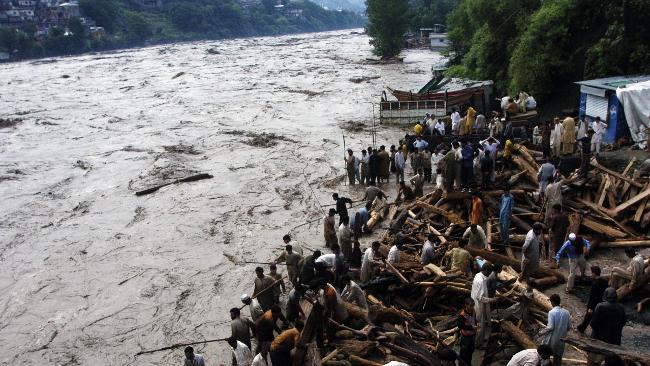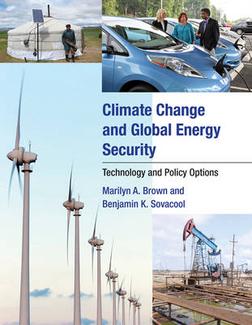 Al Gore didn’t hesitate to dwell on extreme weather events as evidence of the reality of climate change in his closing address for the 24-hour Climate Reality Project last week. There has certainly been no lack of them in the past year or so. Was he pushing the boundaries of the science? It wouldn’t worry me too much if he was because there’s plenty else in the scientific projections which is clearly under way, such as the melting polar ice or the acidification of the oceans. But Gore is a very intelligent and well-informed man and I don’t think he allowed himself to be carried away beyond the scientific mandate. Consider what is being said by some scientists right now. Continue reading “Current extreme weather events part of climate change”
Al Gore didn’t hesitate to dwell on extreme weather events as evidence of the reality of climate change in his closing address for the 24-hour Climate Reality Project last week. There has certainly been no lack of them in the past year or so. Was he pushing the boundaries of the science? It wouldn’t worry me too much if he was because there’s plenty else in the scientific projections which is clearly under way, such as the melting polar ice or the acidification of the oceans. But Gore is a very intelligent and well-informed man and I don’t think he allowed himself to be carried away beyond the scientific mandate. Consider what is being said by some scientists right now. Continue reading “Current extreme weather events part of climate change”
Month: September 2011
Climate Change and Global Energy Security
 Academics Marilyn Brown and Benjamin Sovacool, who have impressive credentials in the field of energy policy, are co-authors of the recently published Climate Change and Global Energy Security: Technology and Policy Options, a substantial and detailed study of a very wide range of technologies covering both the promise of those options and the obstacles to their effective employment.
Academics Marilyn Brown and Benjamin Sovacool, who have impressive credentials in the field of energy policy, are co-authors of the recently published Climate Change and Global Energy Security: Technology and Policy Options, a substantial and detailed study of a very wide range of technologies covering both the promise of those options and the obstacles to their effective employment.
I was deeply depressed by the time I got to page 64 of the book. That was where the tale of five challenges ended. The authors had enlarged the energy and climate change scope of the book somewhat to identify five challenges threatening the prosperity of future generations: electricity, transportation, forestry and agriculture, waste and water, climate change. They do it thoroughly, and it seemed well-nigh impossible that the growing population of the world could possibly cope with these problem areas. But the reader is counselled in the final paragraph of the chapter not to give up in despair, as the issues can be broken down into more manageable challenges to which technology and policy solutions are readily available. Continue reading “Climate Change and Global Energy Security”
A lecture not to miss
 Tim Naish’s lecture, of which we gave notice recently, is now recorded on the Climate Change Research Institute’s website. I warmly recommend it for viewing. Naish is one of the lead authors for the paleoclimate chapter for working group 1 of the IPCC Fifth Assessment Report due in 2013. In this lecture he uses paleoclimate material to provide perspective for the projections of rising global temperature and climate change. We are headed for climates and temperatures that haven’t been seen on the planet for more than a million years and the paleoclimate record helps us to understand what we might expect in terms of polar ice behaviour and sea level rise.
Tim Naish’s lecture, of which we gave notice recently, is now recorded on the Climate Change Research Institute’s website. I warmly recommend it for viewing. Naish is one of the lead authors for the paleoclimate chapter for working group 1 of the IPCC Fifth Assessment Report due in 2013. In this lecture he uses paleoclimate material to provide perspective for the projections of rising global temperature and climate change. We are headed for climates and temperatures that haven’t been seen on the planet for more than a million years and the paleoclimate record helps us to understand what we might expect in terms of polar ice behaviour and sea level rise.
In fact we have to go back 3 million years – to the mid-Pliocene – before we see temperatures like those the models are projecting, 2 to 3 degrees warmer by 2100. The atmospheric CO2 level then was about 400 parts per million. This Pliocene warm period is becoming an important window into what we might expect incoming decades. Continue reading “A lecture not to miss”
The NZ ETS Review 2011: Clear signals for business as usual

Simon Johnson’s guest post offers prompt comment on the ETS review.
Minister for Climate Change Issues Nick Smith has finally released the delayed report of the NZ Emissions Trading Scheme Review 2011. The 98-page report is titled Doing New Zealand’s Fair Share, The Emissions Trading Scheme Review 2011.
The review panel chaired by former Rogernome David Caygill gave their report to Smith on 30 June 2011. Two and half months later and one week into the Rugby World Cup, Smith has let the report out into the world.
From the title of his press release, Slowing of ETS recommended by Review Panel, I think Smith is pretty happy with the report. It also uses some of Smith’s favourite phrases; such as “Doing our fair share” and balancing emissions reductions with costs to businesses.
“The Panel acknowledges there needs to be an appropriate balance between managing these short-term costs and providing a clear long-term direction. Given the current international uncertainty and the challenging state of the economy, this means there should be measures in place which ensure the increase in the costs of the ETS occurs at an appropriate pace.” Continue reading “The NZ ETS Review 2011: Clear signals for business as usual”
The Lesson from China
 Environmentalist Lester Brown is a competitive long-distance runner even into his late seventies. There’s something of the dogged persistence of that sport in the way he keeps delivering the message that humanity must change course, and backing up what he has to say with masses of data. The latest email I received a few days ago from his Earth Policy Institute underlined that message yet again, along with stark figures. It’s a short article headed Learning From China. I was taken with its directness and simplicity and thought it worth sharing here. He reflects that for as long as he can remember his own country, the US, with 5 percent of the world’s population has consumed a third or more of the earth’s resources. But today China consumes more basic resources than the US does. China uses a quarter more grain than the United States. Its meat consumption is double that of the United States. It uses three times as much coal and four times as much steel.
Environmentalist Lester Brown is a competitive long-distance runner even into his late seventies. There’s something of the dogged persistence of that sport in the way he keeps delivering the message that humanity must change course, and backing up what he has to say with masses of data. The latest email I received a few days ago from his Earth Policy Institute underlined that message yet again, along with stark figures. It’s a short article headed Learning From China. I was taken with its directness and simplicity and thought it worth sharing here. He reflects that for as long as he can remember his own country, the US, with 5 percent of the world’s population has consumed a third or more of the earth’s resources. But today China consumes more basic resources than the US does. China uses a quarter more grain than the United States. Its meat consumption is double that of the United States. It uses three times as much coal and four times as much steel.
That’s national consumption. What if per capita consumption in China were to catch up with the US? That will happen by 2035 on the conservative assumption that China’s economy slows from the 11 percent annual growth of recent years to 8 percent.
If the Chinese spend their income more or less as Americans do today, then things get pretty well impossible. Continue reading “The Lesson from China”
